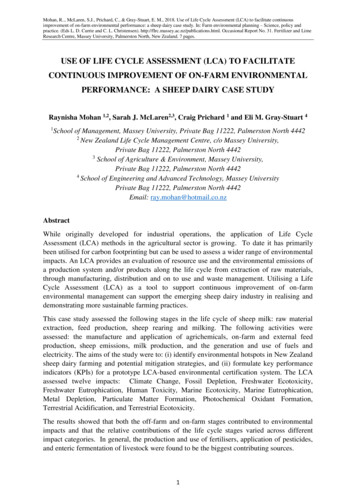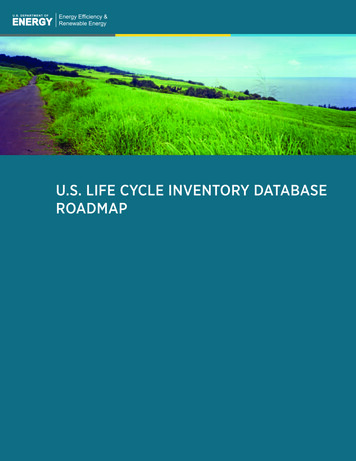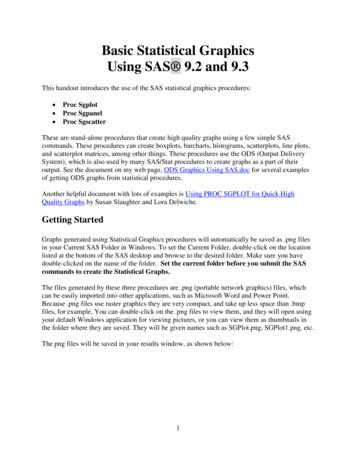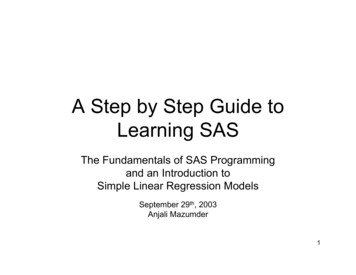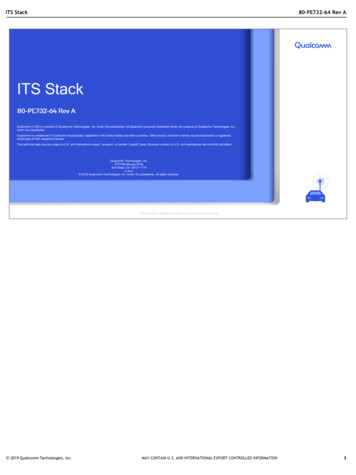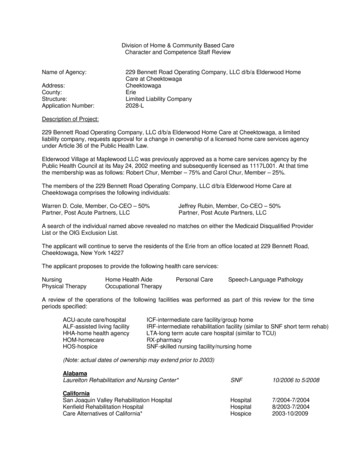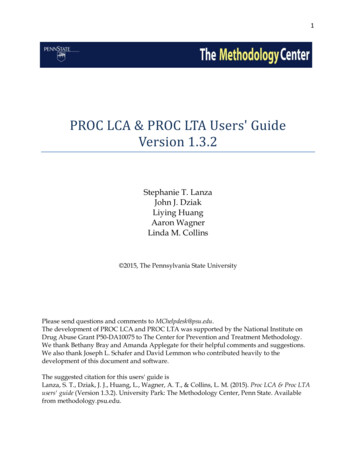
Transcription
1PROC LCA & PROC LTA Users' GuideVersion 1.3.2Stephanie T. LanzaJohn J. DziakLiying HuangAaron WagnerLinda M. Collins 2015, The Pennsylvania State UniversityPlease send questions and comments to MChelpdesk@psu.edu.The development of PROC LCA and PROC LTA was supported by the National Institute onDrug Abuse Grant P50-DA10075 to The Center for Prevention and Treatment Methodology.We thank Bethany Bray and Amanda Applegate for their helpful comments and suggestions.We also thank Joseph L. Schafer and David Lemmon who contributed heavily to thedevelopment of this document and software.The suggested citation for this users' guide isLanza, S. T., Dziak, J. J., Huang, L., Wagner, A. T., & Collins, L. M. (2015). Proc LCA & Proc LTAusers' guide (Version 1.3.2). University Park: The Methodology Center, Penn State. Availablefrom methodology.psu.edu.
2Table of Contents1Overview of Procedures and Recent Improvements . 32The LCA Mathematical Model . 53The LTA Mathematical Model . 74Technical Details . 95674.1Estimation . 94.2Missing Data . 94.3Standard Errors (PROC LCA only) . 94.4Clusters and Weights (PROC LCA only) . 9PROC LCA Syntax . 115.1Invoking the LCA Procedure . 115.2Options for Input . 125.3Options for Output . 135.4Required Statements for PROC LCA . 175.5Optional Statements for PROC LCA . 17PROC LTA Syntax . 246.1Invoking the LTA Procedure . 246.2Required Statements for PROC LTA . 256.3Optional Statements for PROC LTA . 26Appendices: Examples of Use . 317.1Appendix 1: Tutorial Example of Using PROC LCA . 317.2Appendix 2: Complex Sample LCA . 367.3Appendix 3: Minimal PROC LCA Call for Aggregated Data . 397.4Appendix 4: LCA With User-Provided Starting Values and Parameter Restrictions . 407.5Appendix 5: LCA with Individual-Level Data, Grouping Variable and Covariate . 427.6Appendix 6: LTA With User-Provided Starting Values and Parameter Restrictions . 437.7Appendix 7: LTA With Measurement Invariance Across Times . 487.8Appendix 8: LTA With Time 1 Covariates . 497.9Appendix 9: LTA With Time 1 and Transition Covariates . 50References . 51
31Overview of Procedures and Recent ImprovementsPROC LCA and PROC LTA are two related applications that are distributed together.They were developed for SAS for Windows. They are designed for the SAS software packagefor Windows (version 9.1 or higher).1The first procedure, PROC LCA, is a SAS procedure for latent class analysis (LCA). Thisprocedure can be used to estimate latent classes that are measured by categorical indicators. Keyfeatures of PROC LCA include Multiple-groups LCA Option to impose measurement invariance across groups LCA with covariates (prediction of latent class membership) Binary and multinomial logistic regression options for predicting latent class membership The ability to take into account sampling weights and clusters.The second procedure, PROC LTA, is a SAS procedure for latent transition analysis(LTA), in which the latent variable is dynamic and indicators are measured in a longitudinalpanel design. The term “latent status” is used to refer to latent classes that are measuredlongitudinally. Key features of PROC LTA include Multiple-groups LTA Two or more measurement occasions (times) Change over time reflected in transition probabilities Option to impose measurement invariance across groups and/or times LTA with covariates (prediction of latent status membership and transitions) Separate sets of covariates may be specified for Time 1 and for each transition (Time 1 toTime 2, Time 2 to Time 3, etc.) Binary and multinomial logistic regression options for predicting latent statusmembership at Time 1 and modeling transition probabilities.Both PROC LCA and PROC LTA have the following key features: Option for automatic starting values Option for applying data-derived prior in order to stabilize logistic regression (BETAPRIOR) Posterior probabilities can be saved to a SAS data file Parameter estimates can be saved to a SAS data file Input data can be in aggregated (response-pattern data) form or one record per caseThis guide assumes the user has a working knowledge of LCA and LTA. An introductionto these models can be found in Lanza, Bray, and Collins (2013) and Collins and Lanza (2010). Adetailed empirical demonstration of PROC LCA appears in Lanza, Collins, Lemmon, and Schafer(2007), and an empirical demonstration of PROC LTA appears in Lanza and Collins (2008).Important changes from version 1.3.11SAS and all other SAS Institute Inc. product or service names are registered trademarks or trademarks of SASInstitute Inc. in the USA and other countries. indicates USA registration.
4 Addition of OUTCOVB output option for PROC LCA. This is for use with the LCA DistalOutcome macro and does not affect other uses of the procedure.Important changes from version 1.3.0 Bug fixesImportant changes from version 1.2.7 NSTARTS is now available for use in models with covariates. The “best” column has been added to the OUTPOST file. This column indicates whichlatent class is the best match for each individual based on posterior probabilities (i.e.,maximum-probability assignment). The new SEED DRAWS statement allows users to generate 20 random simulations foreach individual’s potential class membership based on posterior probabilities (i.e.,pseudo-class draws) and save them to the OUTPOST file.Important changes from version 1.2.6: Minor bug fixes, to address a memory handling limitation which occurred for certainmodels.Important changes from version 1.2.5: LCA models can now incorporate some complex survey sample features (clustering andweights) taking a pseudo-maximum-likelihood approach (Vermunt & Magidson 2005a,2005b). Covariates can now be included in models even when the data are in aggregated form.Important changes from version 1.2.4: A bug involving the computation of the CAIC fit statistic was corrected.Important changes from version 1.2.3: When a ρ prior is applied to a model with covariates, it is now also applied automaticallyto the null model used to test the significance of each covariate. The output format has been improved to clarify the optimal solution when the NSTARTScommand is used. Messaging in the output window has been improved when priors are applied to β, γ, or ρparameters.Important changes from version 1.1.5: Multiple random starts are now available via the NSTARTS command, to help assess andavoid suboptimal estimates caused by local maxima of the likelihood function. Thestarting seeds and associated likelihoods can be exported to a dataset using theOUTSEEDS option, to help in assessing whether the maximum of the likelihood has beenidentified. Standard errors for parameter estimates are now provided where possible given theparameter estimates. They can be saved to a dataset using the OUTSTDERR option. In place of the older STABILIZE command, the new version of PROC LCA now offers anexpanded set of stabilizing options based on data-derived priors: BETA PRIOR ,GAMMA PRIOR , and RHO PRIOR . The user can stabilize one or more kinds of
5 2parameters, and also choose the strength of the prior. These options are explained furtherin the LCA Syntax section.For users with multiple-core personal computers, faster computation using parallel coresis now available via a CORES statement.The LCA Mathematical ModelUp to three sets of parameters are provided in PROC LCA output: Gamma (γ) parameters: latent class membership probabilities Rho (ρ) parameters: item-response probabilities conditional on latent class membership Beta (β) parameters: logistic regression coefficients for covariates, predicting classmembershipThe ρ parameters express the correspondence between the observed items and the latentclasses, and form the basis for interpretation of the latent classes. When no covariates areincluded, only ρ and γ parameters are estimated. When covariates are included, only ρ and βparameters are estimated; in this case, the γ parameters are calculated as functions of βparameters and the covariates, and are provided in PROC LCA output. If a grouping variable isincluded, all sets of parameters (γ, ρ, β) can be conditioned on group.Suppose we estimate a latent class model with nc classes from a set of M categorical itemsand include a covariate denoted X which may be either continuous or dichotomous (zero/onecoded). Let the vector Yi (Yi1 , , YiM ) represent individual i 's responses to the M items, wherethe possible values of Yim are 1, , rm. Let Li 1, 2,, nc be the latent class membership ofindividual i, and let I(y k) be the indicator function; that is, a function which equals 1 if y equalsk, and 0 otherwise. Suppose we let the last class be the reference class. Let Xi represent the valueof the covariate for individual i; the covariate may be related to the probability of membership ineach latent class, γ, but is assumed to be otherwise unrelated to Yi. Then the contribution byindividual i to the likelihood isncMrmP Yi y X i x l ( x) mk lmI ( y k )(1).The β parameters are the coefficients in logistic regressions using the covariate X tomodel the class membership parameters γ. The γ parameters can be expressed asl 1 l ( x) P( Li l X i x) exp 0l x 1l nc exp j 1for l 1,m 1 k 10j x 1 j exp 0l x 1l nc 11 exp 0 j x 1 j (2)j 1, nc . Note that the latter two terms on the right are equal because we assume that thelast (i.e., the nc th) class is used as the reference class. The reference class has its βs constrained tozero because the relative probabilities of being in the other classes are being compared to theprobability of this reference class. It is necessary to set the βs for some class to zero for the sake ofmodel identifiability, because of the natural constraint that the probabilities for all classes mustsum to one for each individual, but it need not be the last class. The choice of reference class does
6not affect the final fitted probability estimates for any individual or class.This model allows us to estimate the log odds that individual i falls in latent class lrelative to the reference class. For example, if class 2 is the reference class, then the log odds ofmembership in class 1 relative to class 2 for an individual with value x on the covariate is ( x) log 1 01 11 x 2 ( x) .(3)Exponentiated β parameters are odds ratios, reflecting the increase in odds of classmembership (relative to reference class nc ) corresponding to a one-unit increase in the covariate.Note that multiple covariates can be included simultaneously, just as in logistic regression. Formodels involving three or more latent classes, PROC LCA also includes an option to conductbinary logistic regression, as opposed to baseline-category multinomial logistic regression, whenpredicting latent class membership. A comparison class is specified by the user, and all otherlatent classes are combined into one reference group. Covariates are then used to predictmembership in the specified class relative to the others. This option provides a moreparsimonious prediction model and may be useful in some cases where the multinomial logisticregression model is not estimable due to sparseness.
73The LTA Mathematical ModelThe following sets of parameters are estimated in PROC LTA: Delta (δ) parameters: latent status membership probabilities at Time 1 Tau (τ) parameters: probabilities of transitions between latent statuses over time Rho (ρ) parameters: item-response probabilities conditional on latent status membershipand timeThe ρ parameters express the correspondence between the observed items and the latentstatuses, and form the basis for interpretation of the latent statuses. When one or more covariatesare included, two additional sets of β parameters may be estimated: A set of β parameters which are logistic regression coefficients for covariates predictinglatent status membership at Time 1 A further set of β parameters which are logistic regression coefficients for covariatespredicting transitions over time.When covariates are included, only ρ and β parameters need actually be estimated; in thiscase, the δ and τ parameters are calculated as functions of β parameters and the covariates, andare provided in PROC LTA output. If a grouping variable such as gender is included, all sets ofparameters (δ, τ, ρ, β) can be conditioned on group.Suppose a latent transition model with ns latent statuses is to be estimated based on adataset including M categorical response items measured at each of T times for a total of MTitems; a covariate X; and a grouping variable G. LetYi (Yi11 , Yi12 ,, Yi1M , Yi 21 , Yi 22 , , Yi 2 M , , YiT 1 , YiT 2 , , YiTM )represent the vector of individual i 's responses for all times t 1, ,T, and items m 1, ., M,where an individual response Yitm may take on the values 1, 2, , rm. Let S1i 1, 2, , ns beindividual i 's latent status membership at Time 1, S2i 1, 2, , ns be individual i's latent statusmembership at Time 2, and so on. Let I(y k) be the indicator function which equals 1 if y equalsk and 0 otherwise. Let Gi represent individual i's group membership. Finally, let Xi be the valueof the covariate X for individual i; the value of X may be related to the probabilities ofmembership in the latent statuses (the δs) as well as the transition probabilities (the τs). The latenttransition model can then be expressed asP( Yi y X i x, Gi g )ns s1 1ns sT 1s1 g( x ) s2 s1 , g( x) sT sT 1, gMrmT( x ) mk sm, g .m 1 k 1 t 1I ( y k )(4)tThe probability of belonging to latent status s at Time 1 is given by the δ parameter s g ( x) P(S1i s X i x, Gi g ) . As with the γs in LCA, the δs are related to the covariates viaa standard baseline-category multinomial logistic model (see, e.g., Agresti, 2002). For example,with one covariate X, the parameters are expressed as a function of the β parameters (i.e., themultinomial logistic regression coefficient estimates) and X:
8 s g ( x) P( S1i s X i x, Gi g ) exp 0 s g x 1s g ns 11 exp 0 s j x 1s j (5)j 1for s 1, 2,., ns 1 . The nthslatent status serves as the reference class in this logistic regression,which estimates the log-odds that an individual falls in latent status s relative to reference statusns. For example, if latent status 2 is the reference status, then the log-odds of membership in latentstatus 1 relative to latent status 2 for an individual in group 1 with value x on the covariate Χ is ( x) log 1 1 01 1 11 1 x. ( x) 2 1 Exponentiated β parameters are odds ratios. For example, exp(6) 11 1is an odds ratio reflectingthe increase in odds of membership in latent status 1 (relative to the reference latent status, ns)corresponding to a one-unit increase in the covariate, among individuals in group 1.Similarly, s s , g ( x) P( S2i s2 S1i s1, X i x, Gi g ) is determined by a baseline2 1category multinomial logistic model estimating the probability of individual i's move to latentstatus s2 conditional upon current membership in status s1. For example, the probability ofindividual i transitioning from latent status s1 at Time 1 to latent status s2 at Time 2 givenmembership in group g and covariate value x is s s , g ( x ) 2 1 exp 0 sns 12 s1 , g 1 exp 0 sj 1 x 1s2 s1 , j2 s1 , g x 1s 2 s1 , j (7)for s2 1, , ns. (Here latent status ns is serving as the reference status.) Note that more than onecovariate can be included, and different covariates can be specified for δ and for the τ matrices.For models involving three or more latent statuses, PROC LTA also includes an option toconduct binary logistic regression, as opposed to baseline-category multinomial logisticregression, when predicting latent status membership and transitions over time. For eachregression, a comparison status is specified by the user, and all other latent statuses are combinedinto one reference group. Covariates are then used to predict membership in the specified statusrelative to any other status. This option provides a more parsimonious prediction model and maybe used in some cases where the multinomial logistic regression model is not estimable due tosparseness of data, which is most likely to occur in the prediction of transition probabilities.Estimation, missing data on the latent class/status indicators, and determiningconvergence are handled in the same way in PROC LCA and PROC LTA.
94Technical Details4.1 EstimationIn PROC LCA and PROC LTA, parameters are estimated by maximum likelihood usingthe EM algorithm, with Newton-Raphson incorporated into the estimation of regressioncoefficients for covariates. The convergence index used is the maximum absolute deviation(MAD). The MAD associated with a particular iteration of the estimation procedure is computedby calculating the absolute value of the difference between the current iteration parameterestimates and those corresponding to the previous iteration; the value assigned to MAD for thatiteration is the largest number in this array. Ordinarily the value of MAD becomes smaller witheach iteration of the estimation procedure, although there are conditions under which this maynot hold. The estimation procedure iterates until either a previously specified criterion value ofMAD (the convergence criterion) or a previously specified maximum number of iterations isreached.4.2 Missing DataMissing data on the latent class and latent status indicators are permitted in theseprocedures. Missing values should be represented as SAS system missing (“.”) as usual in SAS.When there are missing data the models expressed in Equations 1 and 4 are modified so that theproduct over m 1, , M is replaced by a product over the items observed for that individual.Data are assumed to be missing at random (MAR). A test of the null hypothesis that dataare missing completely at random (MCAR) also appears in the output. Missing data on covariates,groups, clusters, or weights (if these features are included in the model) are not allowed. That is,any record with missing data on covariates, groups, clusters or weights variables specified in themodel is eliminated from the analysis.4.3 Standard Errors (PROC LCA only)Asymptotic standard errors for LCA parameter estimates are provided when available.For models without weights or clustering, standard errors are found by inverting the Hessianmatrix of the log likelihood (see the “standard” option in Latent GOLD; Vermunt & Magidson,2005a, pp. 98-100, for technical details). For models with weights or clustering, a “robust” or“sandwich” standard error based on Taylor linearization is used (see the “robust” option inLatent GOLD).4.4 Clusters and Weights (PROC LCA only)In many contexts in the social sciences, data arise from a sampling scheme morecomplicated than a simple random sample. Very often, participants are selected with unequalprobabilities, so that in order to accurately describe population proportions, observations need tobe given different weights. Also, instead of being independent, participants are often nestedwithin clusters (“primary sampling units”) such as schools, clinics or neighborhoods.
10The current version of PROC LCA can now accomodate clusters and weights using thepseudo-maximum-likelihood approach (Skinner, 1989; Vermunt & Magidson, 2005b, pp. 98-100).Under this approach, sampling weights are first standardized to have an average value of 1 overall of the individuals being analyzed; they are then used as if they were frequency weights incalculating the estimates. Clustering is ignored for estimation purposes, but is taken into accountin calculating standard errors by using a “robust” or “sandwich” style covariance estimate.Note: PROC LCA assumes that all of the data are from the same stratum in the samplingsense.Note: Even if the GROUPS statement is used, the weights are standardized to average to1 across the whole analyzed dataset, not within each group separately. Users who wish to take adifferent approach may standardize weights as they wish prior to conducting the latent classanalysis, and then use the ORIG WEIGHTS option (see p. 13) to specify that original weights beused.Note: Latent GOLD (Vermunt & Magidson, 2005a, 2005b) uses the pseudolikelihoodapproach by default to handle sampling weights and clustering. The pseudolikelihood approachis also one of the two approaches available in MPlus for complex survey data (see Asparouhov,2005; Muthen & Muthen, 2010, p. 233).Note: When weights or clusters are present, inference is done using the “pseudo” or“weighted” log-likelihood function, because the true likelihood taking sampling into accountmay be difficult to find. Therefore, in PROC LCA the G2, AIC, BIC, CAIC, ABIC, and entropystatistics are also based on the log pseudolikelihood. However, the classic literature on thesecriteria generally assumes that they are based on a true log-likelihood from a model with equallyweighted independent observations. This may mean that they are more difficult to interpret ormust be interpreted with more caution because their statistical properties are largely unknown(Vermunt & Magidson 2007). However, they may still be useful as heuristics (Wedel, terHofstede, & Steenkamp, 1998).Note: When weights or clusters are present, the log-likelihood test for the significanceof a covariate is corrected for the effects of the weights and clusters as recommended by Satorraand Bentler (1988) and Asparouhov and Muthén (2005).
115PROC LCA SyntaxThe following statements are available in PROC LCA. Only the bold lines are required;the others are optional.PROC LCA options ;NCLASS value;ITEMS variables;CATEGORIES values;ID variables;GROUPS variables;GROUPNAMES labels;MEASUREMENT keyword;COVARIATES variables;REFERENCE value;BINARY value;CORES value;BETA PRIOR value;GAMMA PRIOR value;RHO PRIOR value;FREQ variable;WEIGHT variable;CLUSTERS variable;ESTIMATION estimation-method;SEED value;SEED DRAWS value;NSTARTS value;MAXITER value;CRITERION value;RUN;5.1 Invoking the LCA ProcedureTo begin the LCA procedure, use the following line of SAS code:PROC LCA DATA SAS-data-set options ;The data file can contain more variables than will be used in the analysis. It must containat least 2 categorical variables to be used as indicators for the latent class model. The data file canbe organized using one record per individual or aggregated with one record per response pattern.
12If data are aggregated, the file must contain a frequency count variable. The first 12 characters ofvariable names will be displayed in the output.There are several options that may be specified in the PROC LCA statement. The optionsmainly concern input and output.5.2 Options for InputSTART SAS-data-setThe START option allows the user to specify a SAS data file containing starting values forthe parameters. This data file must contain starting values for the γ and ρ parameters (startingvalues for β parameters are optional). If starting values for the ρ parameters are of main interest,then the user can simply provide “flat” starting values (1/NCLASS) for the γ parameters andstarting values of 0 for all βs (these are the defaults). The structure of this file must be identical tothat of a file created with the OUTPARAM option (see page 15), except that rows for the βparameters are optional. Appendix 4 provides an example in which starting values are providedin a SAS data set.Note : If the START option is not invoked, the SEED statement (see page 21) must beincluded. If the START option is invoked, the SEED statement and the NSTARTS statement maynot be included. SEED and START may not be specified together.User Tip : When using the START option to specify starting values, a SAS data filecontaining no rows for the β parameters can be used for models with no covariates, as well asmodels with any number of covariates.RESTRICT SAS-data-setThe RESTRICT option allows the user to specify a SAS data file containing parameterrestrictions. Parameter restrictions for the ρ parameters can be useful to help achieve modelidentification or to test specific hypotheses about the measurement of the latent class variable.Parameter restrictions for the γ parameters can be used to test hypotheses about the prevalenceof latent classes, or to fix the probability of membership in a latent class to zero for a particulargroup. The SAS data file containing parameter restrictions must have a structure identical to thatof a file created with the OUTPARAM option (see page 15), except that rows for the β parametersare optional. The file must specify a restriction option, indicated by an integer of value 0 or higher,corresponding to each parameter. Appendix 4 provides an example in which restrictions areprovided in a SAS data set.The following restrictions for ρ and γ parameters are possible. A parameter may be fixed to a specific value. A value of 0 in the parameter restriction fileindicates that the parameter is to be fixed. A parameter that is fixed is not estimated butremains at the starting value provided. If the user wishes to fix parameter estimates to aspecific value, then the START option must be used in conjunction with the RESTRICToption.A parameter may be freely estimated with no restrictions. A value of 1 in the parameter
13 restriction file indicates that the parameter is to be freely estimated (this is also the defaultwhen the RESTRICT option is not used).A parameter may form part of an equivalence set. Integers of value 2 or greater specify anequivalence set; estimates for all parameters with the same value are constrained equal toone another and only one parameter is estimated for each set. Note: This must be restrictedseparately for ρ and γ parameters as needed.Restrictions may not be placed on β parameters. If the SAS data file contains rows for theβ parameters, all restriction values for these parameters should be 1, indicating free estimation.Note : The RESRICT data file should be in order first by parameter type, then by group,then by response category, and last by variable, as in the example in Appendix 4. Optionally, thefile could instead be in order by group, then by parameter type, then by response category, andlast by variable. If they are given in any other arbitrary order then the restrictions may beinterpreted incorrectly by the PROC.Note : If an equivalence set is imposed in the γ parameters, then covariates may not beused to predict class membership.Note : There are a few kinds of restrictions which still allow estimates to be computedbut for which standard errors are unavailable. These are: (1) One or more γs are preset toconstants. (2) Some, but not all, γs are put in equivalence sets. (3) A ρ in a polychotomous item( 2 categories) is constrained but another ρ in the same item is free.Note : If the RESTRICT statement is used then the CLUSTERS statement may not be used.User Tip : For convenience, the MEASUREMENT statement (described on page 18) canbe used to restrict ρ parameters to be invariant across groups without using the RESTRICT option.If both the RESTRICT option and the MEASUREMENT statement are used, restrictionscorresponding to ρ parameters for Group 1 that are provided in the SAS data file are applied toall subsequent groups. Additional information on the use of parameter restrictions can be foundin separate documentation on the Web (WinLTA General Users’ Guide, available atmethodology.psu.edu).ORIG WEIGHTSThis option is only relevant if sampling weights are being used. If this option is notprovided, the weights are standa
LTA with covariates (prediction of latent status membership and transitions) Separate sets of covariates may be specified for Time 1 and for each transition (Time 1 to Time 2, Time 2 to Time 3, etc.) Binary and multinomial logistic regress

